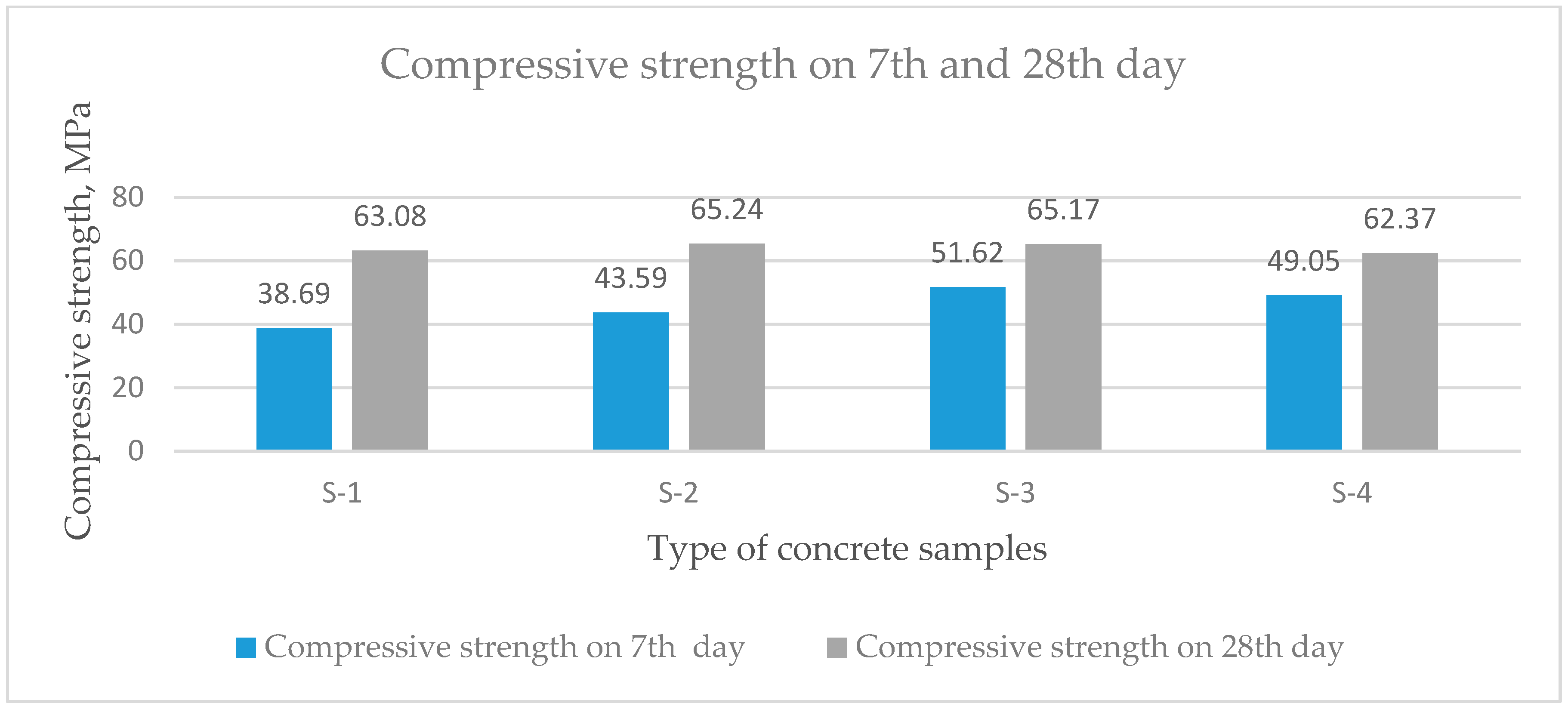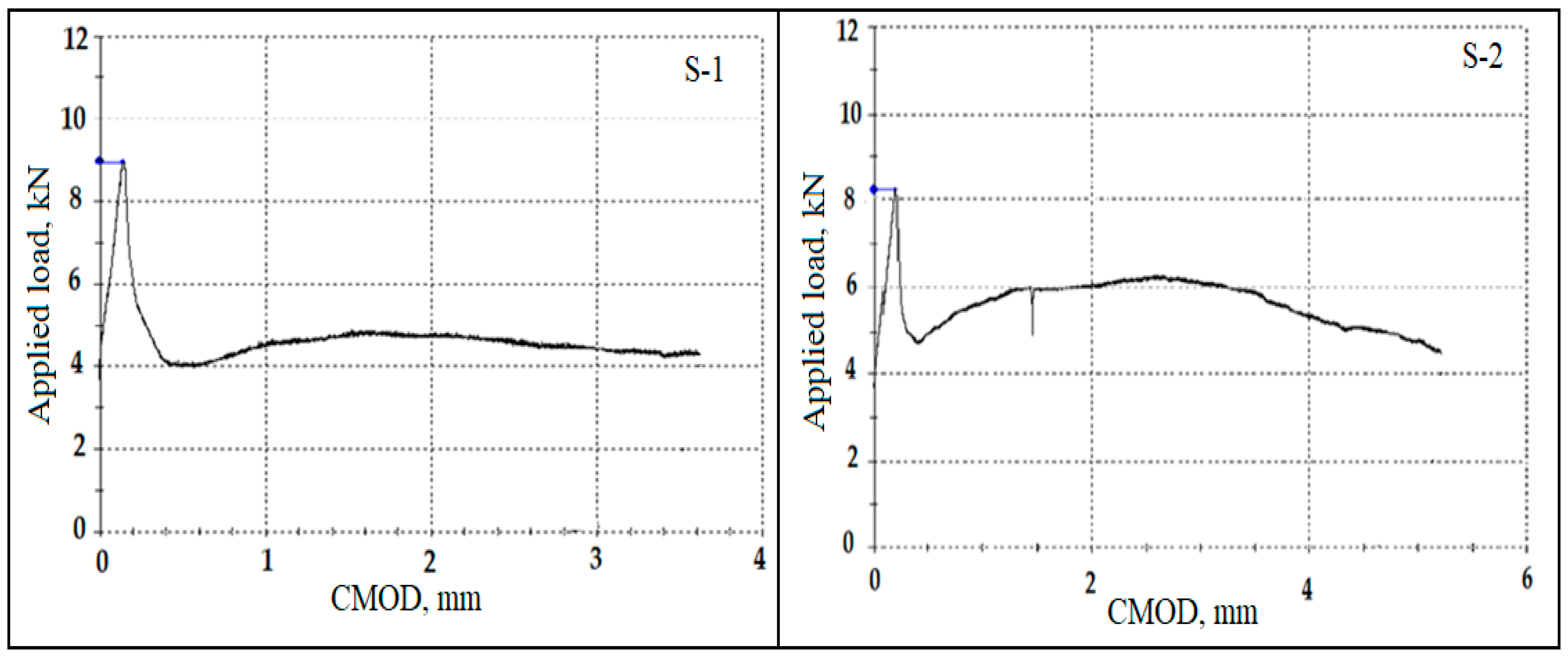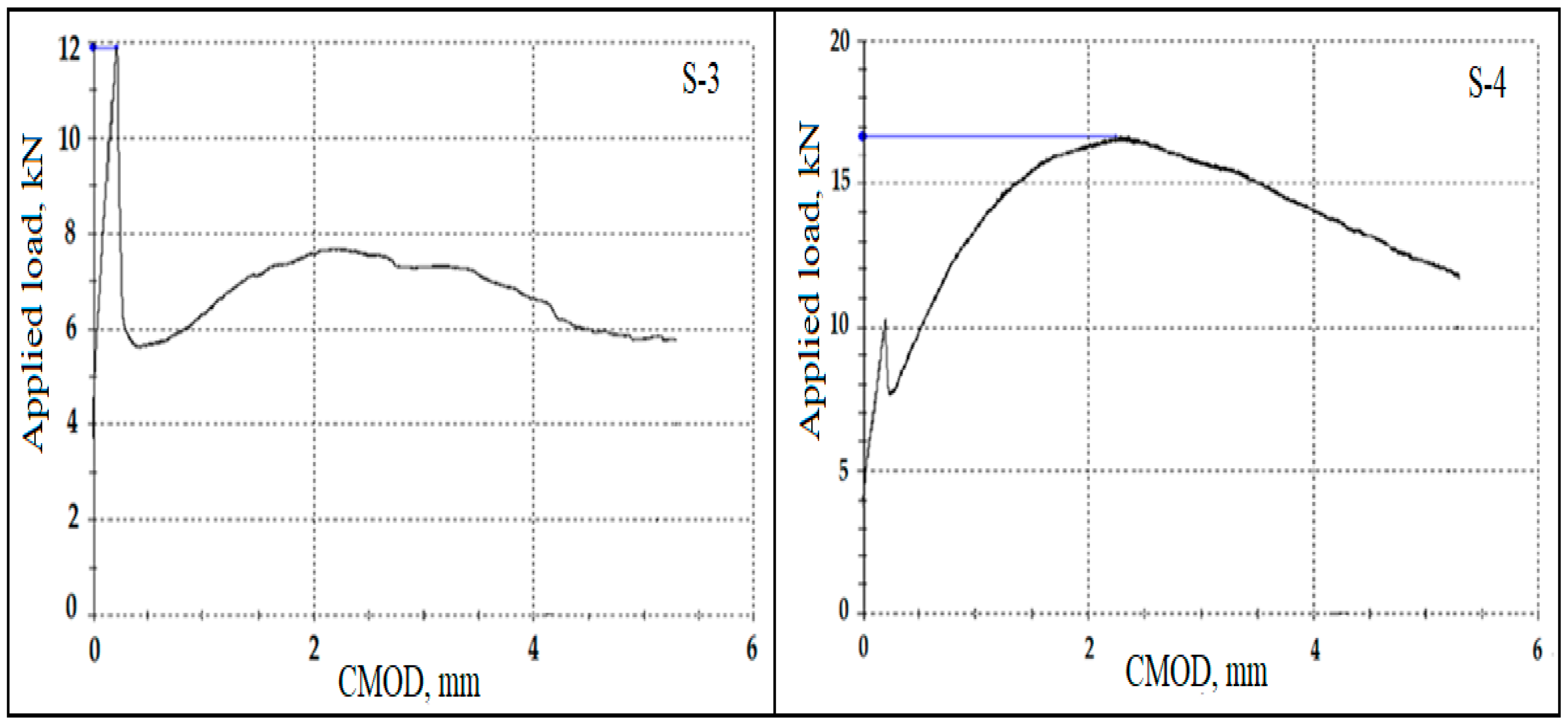Investigation on the Mechanical Properties and Post-Cracking Behavior of Polyolefin Fiber Reinforced Concrete
Abstract
:1. Introduction
2. Used Materials
3. Mechanical Properties Evolution
4. Post-Cracking Behavior Analysis
5. Conclusions
Author Contributions
Funding
Acknowledgments
Conflicts of Interest
References
- Okamura, H.; Ouchi, M. Self-compacting concrete. J. Adv. Concr. Technol. 2003, 1, 5–15. [Google Scholar] [CrossRef]
- D’aloia, L.; Schwartzentruber, R.; Roy, L.; Cordin, J. Rheological behaviour of fresh cement pastes formulated from a self-compacting concrete (SCC). Cem. Concr. Res. 2006, 36, 1203–1213. [Google Scholar]
- Nagamoto, N.; Ozawa, K. Mixture properties of self-compacting, high-performance Concrete. In Proceedings of the Third CANMET/ACI International Conferences on Design and MATERIALS and Recent Advances in Concrete Technology, Kuala Lumpur, Malaysia, 2–5 December 1997; pp. 623–637. [Google Scholar]
- Davis, R.E. Pozzolanic Materials with Special Reference to Their Use in Concrete Pipe; Technical Memorandum; American Concrete Pipe Association: Irving, TX, USA, 1954; pp. 14–15. [Google Scholar]
- Goud, V.; Soni, N.; Varma, G.; Kushwah, K.; Chaurasia, S.; Sharma, V. Partial replacement of cement with fly ash in concrete and its effect. IOSR J. Eng. 2016, 6, 69–75. [Google Scholar]
- Banthia, N.; Gupta, R. Influence of polypropylene fiber geometry on plastic shrinkage cracking in concrete. Cem. Concr. Res. 2006, 36, 1263–1267. [Google Scholar] [CrossRef]
- Shah, S.; Rangan, B. Fiber reinforced concrete properties. J. Am. Concr. Inst. 1971, 68, 126–135. [Google Scholar]
- Brandt, A.M. Fibre reinforced cement-based (FRC) composites after over 40 years of development in building and civil engineering. Compos. Struct. 2008, 86, 3–9. [Google Scholar] [CrossRef]
- Ivorra, S.; Garcés, P.; Catalá, G.; Andión, L.G.; Zornoza, E. Effect of silica fume particle size on mechanical properties of short carbon fiber reinforced concrete. Mater. Des. 2010, 31, 1553–1558. [Google Scholar] [CrossRef]
- Błaszczyński, T.; Przybylska-Fałek, M. Steel fibre reinforced concrete as a structural material. Procedia Eng. 2015, 122, 282–289. [Google Scholar] [CrossRef]
- Nehme, S.G.; László, R.; El Mir, A. Mechanical performance of steel fiber reinforced self-compacting concrete in panels. Procedia Eng. 2017, 196, 90–96. [Google Scholar] [CrossRef]
- Nilforoush, R.; Nilsson, M.; Elfgren, L. Experimental evaluation of tensile behaviour of single cast-in-place anchor bolts in plain and steel fibre-reinforced normal- and high-strength concrete. Eng. Struct. 2017, 147, 195–206. [Google Scholar] [CrossRef]
- Pająka, M.; Ponikiewski, T. Investigation on concrete reinforced with two types of hooked fibers under flexure. Procedia Eng. 2017, 193, 128–135. [Google Scholar] [CrossRef]
- Raczkiewicz, W. The effect of micro-reinforcement steel fibers addition on the size of the shrinkage of concrete and corrosion process of the main reinforcement bars. Procedia Eng. 2017, 195, 155–162. [Google Scholar] [CrossRef]
- Aylie, H.; Okiyarta, A.W. Experimental study of steel-fiber reinforced concrete beams with confinement. Procedia Eng. 2015, 125, 1030–1035. [Google Scholar] [CrossRef]
- Alizade, E.; Jandaghi, A.F.; Zabihi, S. Effect of steel fiber corrosion on mechanical properties of steel fiber reinforced concrete. Asian J. Civ. Eng. 2016, 17, 147–158. [Google Scholar]
- Berrocal, C.G.; Lundgren, K.; Löfgren, I. Influence of steel fibers on corrosion of reinforcement in concrete in chloride environments: A review. In Proceedings of the 7th International Conference Fibre Concrete 2013, Prague, Czech Republic, 12–13 September 2013. [Google Scholar]
- Anandan, S.; Manoharan, S.V.; Sengottian, T. Corrosion effects on the strength properties of steel fibre reinforced concrete containing slag and corrosion inhibitor. Int. J. Corros. 2014, 2014, 595040. [Google Scholar] [CrossRef]
- Granju, J.L.; Balouch, S.U. Corrosion of steel fiber reinforced concrete from the cracks. Cem. Concr. Res. 2005, 35, 572–577. [Google Scholar] [CrossRef]
- Mihashi, H.; Ahmed, S.F.U.; Kobayakawa, A. Corrosion of reinforcement steel in steel fiber reinforced concrete structures. J. Adv. Concr. Tech. 2011, 9, 159–167. [Google Scholar] [CrossRef]
- Bagherzadeh, R.; Pakravan, H.R.; Sadeghi, A.; Latifi, M.; Merati, A.A. An investigation on adding polypropylene fibers to reinforce lightweight cement composites. J. Eng. Fibers Fabr. 2012, 7, 13–19. [Google Scholar] [CrossRef]
- Tagnit, A.; Vanhove, Y.; Petrov, N. Microstructural analysis of the bond mechanism between polyolefin fibers and cement pastes. Cem. Concr. Res. 2005, 35, 364370. [Google Scholar]
- Neeley, B.D.; O’Neil, E.F. Polyolefin fiber reinforced concrete. In Proceedings of the Materials Engineering Conference: Materials for the New Millennium, Washington, DC, USA, 10–14 November 1996; Volume 1, pp. 113–122. [Google Scholar]
- Lin, W.; Cheng, A. Effect of polyolefin fibers and supplementary cementitious materials on corrosion behavior of cement-based composites. J. Inorg. Organomet. Polym. 2013, 23, 888–896. [Google Scholar] [CrossRef]
- Mindess, S.; Wang, N.; Rich, L.D.; Morgan, D.R. Impact resistance of polyolefin fiber reinforced precast units. Cem. Concr. Compos. 1998, 20, 387–392. [Google Scholar] [CrossRef]
- Wan Ibrahim, M.H.; Jamaludin, N.; Irwan, J.M.; Ramadhansyah, P.J.; Suraya Hani, A. Compressive and flexural strength of foamed concrete containing polyolefin fibers. Adv. Mater. Res. 2014, 91, 489–493. [Google Scholar] [CrossRef]
- Maruthachalam, D.; Padmanaban, I.; Vishnuram, B.G. Influence of polyolefin macro-monofilament fibre on mechanical properties of high-performance concrete. Ksce J. Civ. Eng. 2013, 17, 1682–1689. [Google Scholar] [CrossRef]
- Cement. Composition, Specifications and Conformity Criteria for Common Cements; BS EN 197-1:2011; BSI: London, UK, 2011.
- MasterGlenium® SKY 8700, BASF New generation superplasticising admixture for extended slump retention. Technical data sheet. Available online: https://assets.master-builders-solutions.basf.com/shared%20documents/pdf/english%20(australia)/basf-masterglenium-sky-8700-tds.pdf (accessed on 20 November 2018).
- Testing Fresh Concrete, Part 2: Slump-Test; BS EN 12350-2; BSI: London, UK, 2009.
- Methods of Testing Cement. Part 1: Determination of Strength; BS EN 196-1:2016; BSI: London, UK, 2016; ISBN 9780580845802.
- Feng, J.; Sun, J.; Yan, P. The influence of ground fly ash on cement hydration and mechanical property of mortar. Adv. Civ. Eng. 2018, 2018, 4023178. [Google Scholar] [CrossRef]
- Saha, A.K. Effect of class F fly ash on the durability properties of concrete. Sustain. Environ. Res. 2018, 28, 25–31. [Google Scholar] [CrossRef]
- Test Method for Metallic Fibre Concrete Measuring the Flexural Tensile Strength (Limit of Proportionality (LOP), Residual); BS EN 14651:2005+A1:2007; BSI: London, UK, 2005.
- Adhikary, S.K.; Rudzionis, Z. Behavior of concrete under the addition of high volume of polyolefin macro fiber and fly ash. Fibers 2018, 6, 38. [Google Scholar] [CrossRef]
- Rizzuti, L.; Bencardino, F. Effects of Fibre Volume Fraction on the Compressive and Flexural Experimental Behaviour of SFRC. Contemp. Eng. Sci. 2014, 7, 379–390. [Google Scholar] [CrossRef]
- Bencardino, F.; Rizzuti, L.; Spadea, G.; Swamy, R.N. Implications of test methodology on postcracking and fracture behavior of Steel Fibre Reinforced Concrete. Composites Part B 2013, 46, 31–38. [Google Scholar] [CrossRef]








| Materials Used for Concrete Mixture Preparation | Quantity of the Materials for 1 m3 Concrete | |
|---|---|---|
| Fine aggregate | 2 mm | 160.5 kg |
| 4 mm | 696.8 kg | |
| Coarse aggregate | 827.9 kg | |
| Cement | 400 kg | |
| Water | 181.6 kg (W/B ratio 0.36) | |
| Fly ash | 100 kg (25% of cement mass) | |
| Super plasticizer | 7.5 kg (1.5% of cement mass) | |
| Polyolefin fibers | S-1 | 3 kg |
| S-2 | 4.5 kg | |
| S-3 | 6 kg | |
| S-4 | 9 kg | |
© 2019 by the authors. Licensee MDPI, Basel, Switzerland. This article is an open access article distributed under the terms and conditions of the Creative Commons Attribution (CC BY) license (http://creativecommons.org/licenses/by/4.0/).
Share and Cite
Adhikary, S.K.; Rudzionis, Z.; Balakrishnan, A.; Jayakumar, V. Investigation on the Mechanical Properties and Post-Cracking Behavior of Polyolefin Fiber Reinforced Concrete. Fibers 2019, 7, 8. https://0-doi-org.brum.beds.ac.uk/10.3390/fib7010008
Adhikary SK, Rudzionis Z, Balakrishnan A, Jayakumar V. Investigation on the Mechanical Properties and Post-Cracking Behavior of Polyolefin Fiber Reinforced Concrete. Fibers. 2019; 7(1):8. https://0-doi-org.brum.beds.ac.uk/10.3390/fib7010008
Chicago/Turabian StyleAdhikary, Suman Kumar, Zymantas Rudzionis, Arvind Balakrishnan, and Vignesh Jayakumar. 2019. "Investigation on the Mechanical Properties and Post-Cracking Behavior of Polyolefin Fiber Reinforced Concrete" Fibers 7, no. 1: 8. https://0-doi-org.brum.beds.ac.uk/10.3390/fib7010008







